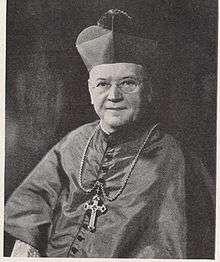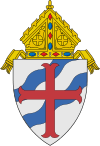Joseph Schrembs
| The Most Reverend Joseph Schrembs | |
|---|---|
| Roman Catholic Bishop of Cleveland | |
 | |
| Church | Roman Catholic Church |
| See | Cleveland |
| In office | June 16, 1921–November 2, 1945 |
| Predecessor | John Patrick Farrelly |
| Successor | Edward Francis Hoban |
| Orders | |
| Ordination |
June 29, 1889 by Henry Richter |
| Consecration |
February 22, 1911 |
| Personal details | |
| Born |
March 12, 1866 Wutzlhofen, Regensburg, Germany |
| Died |
November 2, 1945 (aged 79) Cleveland, Ohio, United States |
| Buried | Cathedral Resurrection Chapel |
| Nationality | German |
| Previous post |
Priest of the Diocese of Grand Rapids (1889–1911) Auxiliary Bishop of the Diocese of Grand Rapids (February 22, 1911-August 1, 1911) Bishop of the Diocese of Toledo (1911-1921) |
Joseph Schrembs (March 12, 1866 – November 2, 1945) was a German-born prelate of the Roman Catholic Church. He served as the bishop of the Diocese of Toledo (1911–21) and the Diocese of Cleveland, Ohio (1921–45).
Biography
Early life and education
Joseph Schrembs was born in the village of Wutzlhofen (since 1924 a township of Regensburg), Bavaria. One of sixteen children, he was born to George and Mary (née Gäß) Schrembs. Shortly afterwards he and his family moved to Regensburg, where Joseph received his early education. In 1877 he came to the United States under the patronage of Bishop Rupert Seidenbusch, and enrolled at St. Vincent's College in Latrobe, Pennsylvania, where his older brother Rudesind had become a Benedictine monk.[1] After completing his classical course at St. Vincent's at age sixteen, he taught at the parochial school of St. Martin's Church[2] until 1884. He was then accepted as a seminarian by Bishop Henry Richter of Grand Rapids, Michigan, who sent him to study philosophy and theology at the Grand Seminary of Montreal in Quebec, Canada.
Ordination and ministry
Returning to Grand Rapids in March 1889, Schrembs was ordained to the priesthood by Bishop Richter on June 29, 1889.[3] He then served as a curate at St. Mary's Church in Saginaw until 1895, when he became pastor of St. Mary of the Assumption Church[4] in West Bay City, Michigan, where he preached every Sunday in both English and French.
He was named pastor of St. Mary Church in Grand Rapids in 1900. St. Mary’s parish was established in 1857 to meet the spiritual needs of the German population in the Grand Rapids area. While on a tour of Europe in 1902, Father Schrembs purchased a grotto of Our Lady of Lourdes, which is still present in the church.
In 1903 he was named vicar general of the Diocese of Grand Rapids.[1] During his tenure as pastor, St. Mary's school was used as a local relief station when the Grand River flooded in 1904, and in 1905, a new convent was built for the sisters. In January 1906 he was raised to the rank of Domestic Prelate of His Holiness by Pope Pius X.[1] Under the direction of Monsignor Schrembs, collections were taken up for victims of the 1906 San Francisco earthquake and in 1907 he presided over St. Mary's Parish Golden Jubilee.[5]
Auxiliary Bishop of Grand Rapids, Michigan
On January 8, 1911, Schrembs was appointed Auxiliary Bishop of Grand Rapids and Titular Bishop of Sophene by Pius X.[3] He received his episcopal consecration on the following February 22 from Bishop Richter, with Bishops Camillus Paul Maes and John Samuel Foley serving as co-consecrators.[3]
Bishop of Toledo, Ohio
Shortly after his consecration in February, Schrembs was named the first Bishop of Toledo, Ohio, on August 11, 1911.[3] Schrembs requested the Sisters of Saint Francis of Rochester, Minnesota send members to the Toledo area to work with the children of the Polish immigrants. Sister Adelaide Sandusky, directress of the College of St. Teresa and 22 other Sisters established a home in Toledo and began teaching in area schools. This community became the Sisters of St. Francis of Sylvania, Ohio [6] From 1911 to 1921 Bishop Schrembs established thirteen new parishes and thirtythree schools. At Bishop Schrembs invitation, Visitation nuns came to Toledo in 1915 from the Georgetown (Washington, D.C.) Monastery.[7]
In a September 27, 1914 sermon in Baltimore, before a meeting of the American Federation of Catholic Societies, Schrembs criticized the failure of the United States government to insist upon the protection of Catholics in Mexico.[8] During World War I, he served on the Administrative Committee of the National Catholic War Council.[9][10]
Bishop of Cleveland, Ohio
On June 16, 1921, he was appointed the fifth Bishop of Cleveland.[3]
Schrembs once described Prohibition as "fanaticism."[11]
On June 12, 1924, he offered the invocation at the opening of the third day of the 1924 Republican National Convention; he characterized President Calvin Coolidge as "a chieftain whose record of faithful public service, and whose personality, untarnished and untainted by the pollution of political corruption, will fill the heart of America with the new hope of a second spring."[12]
In 1925 the body of St. Christine was presented to Schrembs by Pope Pius XI, and moved from its resting place in a Roman monastery to St. John's Cathedral.[13]
When physicist Charles F. Brush advocated birth control as a means of the "betterment of the human stock" and population control, Schrembs condemned his remarks, saying, "In older times we referred to humans as the human race, but according to this foundation we are being classed with the animals on the farm, the cow, the horse, the mule...According to this foundation, I have no right to be born, for I am the youngest of 16 children and God bless my mother for every one of them!"[14]
He promoted the cause for canonization of Kateri Tekakwitha.[15]
When fan dancer Sally Rand rode in Cleveland's St. Patrick's Day parade in 1937 next to a float dedicated to the Virgin Mary, Schrembs declared, "I am deeply humiliated and ashamed...[Rand's] inclusion does not represent the mind of the great Irish people."[16]
Schrembs was given the personal title of Archbishop on March 25, 1939.[3] In 1940 he placed Holy Redeemer Church in Cleveland under interdict for refusing to accept his appointment as pastor.[17] During his tenure, he erected 27 parishes in Cleveland and 35 outside the city.
See also
- Catholic Church hierarchy
- Catholic Church in the United States
- Historical list of the Catholic bishops of the United States
- List of the Catholic bishops of the United States
- Lists of patriarchs, archbishops, and bishops
References
- 1 2 3 "Toledo (Ohio)". Catholic Encyclopedia.
- ↑ St. Martin of Tours Catholic Church, Louisville, Kentucky in Louisville, Kentucky,
- 1 2 3 4 5 6 "Archbishop Joseph Schrembs". Catholic-Hierarchy.org.
- ↑ St. Mary of the Assumption Church Archived January 5, 2009, at the Wayback Machine.
- ↑ "Pastors of St. Mary's", St. Mary Catholic Church, Grand Rapids, Michigan
- ↑ Sylvania Franciscans
- ↑ The Sisters of the Visitation, Toledo, Ohio
- ↑ "Bishop of Toledo Demands That Something Be Done In Mexico", The New York Times September 28, 1914
- ↑ Poluse, Martin. "Archbishop Joseph Schrembs's Battle to Obtain Public Assistance for the Parochial Schools of Cleveland during the Great Depression", The Catholic Historical Review, vol.83, no. 3, July 1997
- ↑ The Elevator Constructor, Volumes 15-16, p.14, International Union of Elevator Constructors., 1918
- ↑ "Milestones". TIME Magazine. 1945-11-12.
- ↑ Official Report of the Proceedings of the Eighteenth Republican National Convention, published by the Republican National Committee (1924), pp. 125-26
- ↑ "Saint's Body". TIME Magazine. 1925-08-03.
- ↑ "Better Babies". TIME Magazine. 1928-07-02.
- ↑ "Saintly Causes". TIME Magazine. 1935-11-18.
- ↑ "People". TIME Magazine. 1937-03-29.
- ↑ "Interdict". TIME Magazine. 1940-03-04.
External links
- Photosite of Rt. Rev. Bishop Schrembs
- Roman Catholic Diocese of Cleveland
- Roman Catholic Diocese of Grand Rapids
- Roman Catholic Diocese of Toledo
Episcopal succession
| Catholic Church titles | ||
|---|---|---|
| Preceded by John Patrick Farrelly |
Bishop of Cleveland 1921–1945 |
Succeeded by Edward Francis Hoban |
| Preceded by none |
Bishop of Toledo 1911–1921 |
Succeeded by Samuel Stritch |
| Preceded by – |
Auxiliary Bishop of Grand Rapids 1911–1911 |
Succeeded by – |


